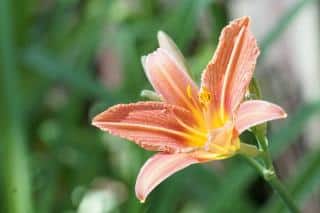

Daylily is also called hemerocallis. Its magnificent flowers only last a very short time.
Main Daylily facts
Name – Hemerocallis
Family – Liliaceae (lily family)
Type – perennial
Height – 20 to 40 inches (50 to 100 cm)
Exposure – full sun, part sun
Soil – ordinary, rather clayish
Foliage: evergreen – Flowering: June to September
Both in pots and directly in the ground, it requires a little care to make the blooming more expansive.
This flower loves partly shaded growing beds, and, if it doesn’t get too hat, sunny exposure.
Whether in a pot or in the ground, prefer light sun and make sure the spot doesn’t get too much wind.
It is recommended to plant daylily in fall even though you can plant all the way up to spring if you avoid frost spells.
Though not technically a bulb flower, you can follow the same exact planting steps as you would when planting bulbs.
Repotting in spring will let the plant develop well.
Select flower plant soil mix for this.
To keep your daylilies as long as possible, proceed to divide the crown after the blooming. The rhizomes will sprout new leaves and flowers that are identical to the mother plant.
Seeds, which appear on most varieties, will inherit some of the mother plant’s traits, but it’s a bit unpredictable due to cross-pollination.
Daylily is a plant that requires very little work, not to say none. It is very easygoing and propagates on its own as years go by.
Although the following aren’t compulsory, here is how you can make the blooming even more amazing.
 This perennial, native to Asia, is also called “Hemerocallis“ and its blooming is very cute but lasts for only 24h.
This perennial, native to Asia, is also called “Hemerocallis“ and its blooming is very cute but lasts for only 24h.
It has the advantage of bearing evergreen leaves and boasting very beautiful flowers that appear in ranges of red, orange and yellow.
In a flower bed or as a cut flower in a vase, it is extremely striking.
Upon planting, feel free to enrich the soil with soil mix and even manure and seaweed compost.